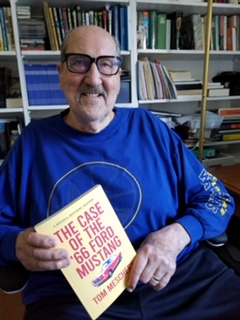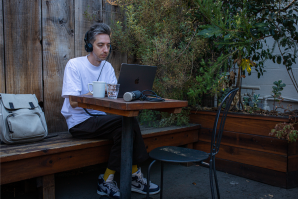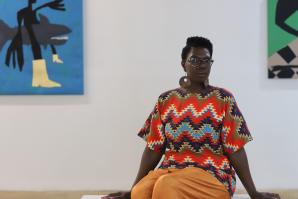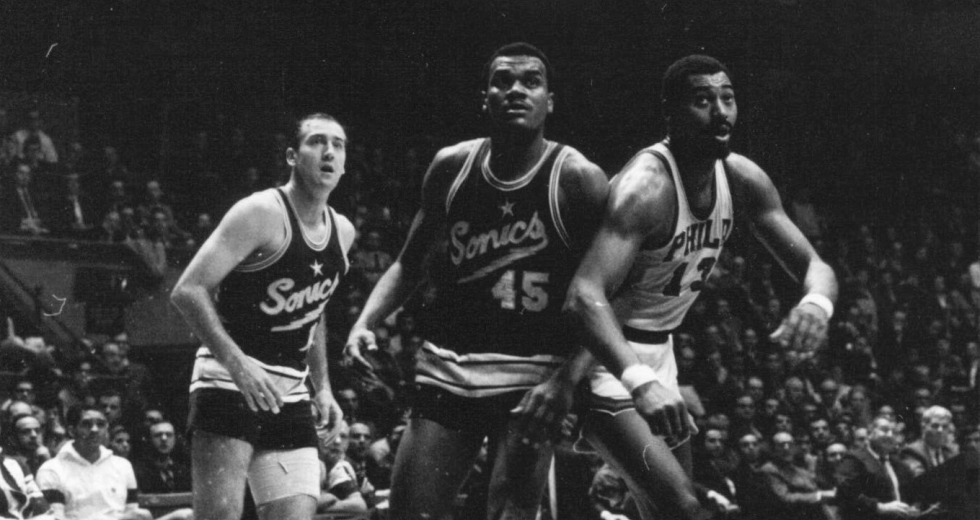Tom Meschery is celebrating the recent release of “The Case of
the ‘66 Ford Mustang.” (Courtesy photo)

Meschery draws from his basketball background in “The Case of the ‘66 Ford Mustang” with a nod to his famed Warriors teammate, the late Nate Thurmond, by setting part of the story in Thurmond’s real-life soul-food eatery, Big Nate’s Barbecue. In his upcoming stand-alone novel, “The Kid Has Hops,” Meschery focuses more on his history on the hardcourt. “Hops” is set for release in early 2025, when Meschery will be 86 years old.
As if this were not enough, Meschery plans to release his memoir, “The Mad Manchurian,” in August 2024. And so far his own story has been one that the most imaginative of novelists would be hard-pressed to dream up.
Born Tomislav Nikolayevich Mescheryakov in Manchuria after his parents fled the Bolshevik Revolution, Meschery lived in an internment camp near Tokyo during World War II. His family later settled in San Francisco. It was there, at age 8, where Meschery began to overcome his awkwardness as a foreigner through athletic prowess. He came home from school one day crying about being different from his peers, namely in the way he talked and dressed. But acceptance came in a kickball game when Meschery booted the ball clean out of the playground.
He established himself as a basketball star at San Francisco’s Lowell High School, subsequently reaching the heights of first-team All-American at St. Mary’s College in the East Bay City of Moraga. Meschery was the No. 7 overall pick in the 1961 NBA draft, acquired by the Philadelphia Warriors. Though he prefers the moniker “The Mad Manchurian,” obtained from his intensity on the court, Meschery has also been referred to as the “Forrest Gump of the NBA” for his knack of being around during momentous times in the league. During Wilt Chamberlain’s storied 100-point game, he was on the court as a forward, scoring 16 points of his own. Meschery scoffs that if he stowed away the game ball he’d have untold wealth today.
Naturally, Meschery was elated during the offseason of his rookie year while serving in the Army Reserve. It was then that he received notification that he would be joining the Warriors the following season in their move to San Francisco. After six years with the Warriors Meschery brought his sneakers to Seattle as part of the NBA expansion draft, becoming one of the original Supersonics. He retired as a player in 1971 and the following season served as head coach for the Carolina Cougars of the American Basketball Association. Three seasons later, he was lured by former Sonics teammate and subsequent hall of famer Lenny Wilkens to be his assistant coach for the NBA’s Portland Trail Blazers and stayed for two years. Meschery is now immortalized in the rafters at San Francisco’s Chase Center, along with Wilt Chamberlain, Nate Thurmond and three additional Warriors, where his jersey number, 14, is retired.
Meschery obtained his teaching credential from the University of Nevada, Reno, and subsequently taught high school English in the same city, commuting from Truckee while raising two daughters and a son. After a 23-year career in education, which included creative writing instruction at Sierra College, he left the classroom in 2006.
Meschery and his wife, artist Melanie Marchant Meschery, moved to Sacramento in the summer of 2008. He says he’s adopted a fondness for this locale and how it melds with his life.
An introduction to “The Case of the ‘66 Ford Mustang”: Victor Brovelli receives a call from his friend Detective Sergeant Jay Ness that his older brother and his girlfriend Grace have been found shot to death in his ‘66 Ford Mustang, a possible murder-homicide. Victor does not believe his brother would murder Grace and commit suicide, so begins his attempt to clear his brother’s name by proving that the two were murdered by an unknown killer. The case leads Victor into the dark world of the IRA (Irish Republican Army) and Irish nationalism and northern provisionals. Once again Victor is assisted by his fiance Dila Agbo, an African American who works for the Black Panthers.
The power of teaching teenagers: First of all, it kept me young and gave me energy. Second, it made me a better listener. Third, it provided me a lot about imagination. Classrooms are filled with magic. Fourth, I learned to examine a wide range of possibilities. Students are raw human material; learning to understand them, you can understand anybody, no matter what age.
Things to love about Sacramento: Sacramento is the home of Melanie. I know I would be happy wherever she lives. I have come to love Sacramento as a city for its trees, its closeness to the mountains, without having to live in the snow anymore. I did that for 35 years in Truckee.
Sacramento is truly an arbor city and a river city. I love rivers. I love that it is not a complicated city and easy to live in. It is a restful city. One must find peace in the place he or she puts down his or her roots. I would live in Paris and New York in a heartbeat, the same is true for San Francisco, but all three require too much of one’s energy to navigate anymore at my age. Perhaps if I was 20 or 30 again. Sacramento is an all-one’s-life kind of city for me.
We live in an area called Campus Commons, within walking distance of Sacramento State University and the American River and a very easy drive to downtown Sacramento and the Capitol. It is a planned neighborhood of condominiums and homes built around two lakes with lots of trees and green space. There are ducks and geese and a flock of wild turkeys that make their way up from the river to wander the grounds and enchant our grandchildren.
Author role models: I grew up in a Russian literary household. My maternal grandmother is a Tolstoy. She was a cousin to writers Leo, the novelist, and Aleksey Tolstoy, the poet (and multi-genre writer). Words are in my blood.
Tony Hillerman and Henning Mankell have inspired my writing mysteries. In general, I am devoted to the stories of Flannery O’Connor and the novels of Toni Morrison, Ernest Hemingway, Fyodor Dostoevsky and Charles Dickens. As a poet, I have been influenced by James Wright, Robert Hass and Mary Oliver.
Writing as reinvention: I didn’t consciously, but in retrospect I must have been thinking that I needed something to do with my life that was engaging and emotionally powerful as playing basketball in the NBA. I lucked out. I found teaching, and I always had writing, but I didn’t fully realize how essential that was going to be until later in my life. Teaching was a transition career for me.
An obsession for life: Once I decide I love doing something, whether it be basketball, teaching or writing, I have to do it wholeheartedly. It is always about living a creative, engaged life. These were the three horses I have been harnessed to from the beginning. Of the three, writing is what’s left to me in my old age, and it will be what keeps me going as a creative person until I die.
Edited for length and clarity.
–
Stay up to date on art and culture in the Capital Region: Subscribe to the Comstock’s newsletter today.
Recommended For You

Getting to Know: Mallory Maupin and Samuel Rose
Local fashion duo launches Topstitch, a production house for education, design and manufacturing in Sacramento
In their brightly lit, smartly appointed shop in Midtown, Topstitch owners Mallory Maupin and Samuel Rose teach workshops, fulfill custom orders, consult on product development and work on their own projects.

Getting to Know: Mayra Vega
Woodland's mayor serves with an inclusive perspective and inclination for tech
As a full time director of communications in the health care field, Woodland Mayor Mayra Vega cares about including the underrepresented and boosting the city’s tech jobs.

Getting to Know: Cole Cuchna
Podcast host makes a career out of analyzing the biggest albums in hip-hop
With “Dissect,” Cole Cuchna goes deep into his favorite
music albums, cultivating curiosity in others. Now nine
seasons in, he’s found success with a Spotify partnership
and a talk at TEDxBerkeley.

Getting to Know: Faith J. McKinnie
Gallerist Faith J. McKinnie is highlighting the work she wants to
see in her Midtown gallery that highlights contemporary art
by underrepresented artists.

Dilemma of the Month: How Do You Document Harassment Without Getting Yourself in Hot Water?
HR people often advise victims of harassment to “just document everything!” without explaining how to go about it. Here’s a quick guide to what you need to do when you’re documenting harassment.

What Does the New Workplace Harassment Guide for California Employers Mean For Your Business?
Watch any news channel, listen to any talk radio station or read virtually any online news or social media feed, and chances are, you’ll learn about a new lawsuit being filed against a company based on allegations of harassment, discrimination or retaliatory conduct in the workplace.



